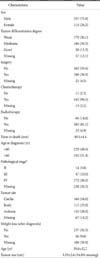2. Mohagheghi M, editor. Annual Report of Tehran Cancer Registry 1999. Tehran: The Cancer Institute Publication;2004.
3. Mohagheghi M, Musavi Jarahi A, Shariat Torbaghan S, Zeraati H, editors. Annual Report of Tehran University of Medical Sciences District Cancer Registry 1997. Tehran: The Cancer Institute Publication;1998.
4. Biglarian A, Hajizadeh E, Gouhari MR, Khodabakhshi R. Survival analysis of patients with gastric adenocarcinomas and factors related. Kowsar Med J. 2008; 12:337–347.
5. Zeraati H, Mahmoudi M, Kazemnejad A, Mohammad K. Postoperative survival in gastric cancer patients and its associated factors: a time dependent covariates model. Iranian J Public Health. 2006; 35:40–46.
6. Barnard J, Meng XL. Applications of multiple imputation in medical studies: from AIDS to NHANES. Stat Method Med Res. 1999; 8:17–36.

7. Burton A, Altman DG. Missing covariate data within cancer prognostic studies: a review of current reporting and proposed guidelines. Br J Cancer. 2004; 91:4–8.

8. Pourhoseingholi MA, Hajizadeh E, Moghimi Dehkordi B, Safaee A, Abadi A, Zali MR. Comparing Cox regression and parametric models for survival of patients with gastric carcinoma. Asian Pac J Cancer Prev. 2007; 8:412–416.
9. Roushanaei G, Kazemnejad A, Sedighi S. Postoperative survival estimation of gastric cancer patients in cancer institute of Tehran, Imam Khomeini hospital and its relative factors. Sci J Hamadan Univ Med Sci. 2010; 17:13–18.
10. Im WJ, Kim MG, Ha TK, Kwon SJ. Tumor size as a prognostic factor in gastric cancer patient. J Gastric Cancer. 2012; 12:164–172.

11. Little RJ, Rubin DB, editors. Statistical Analysis with Missing Data. New York: John Wiley & Sons;2002.
12. Kleinbaum DG, Klein M, editors. Survival Analysis. 3rd ed. New York: Springer;2012.
13. Barzi F, Woodward M. Imputations of missing values in practice: results from imputations of serum cholesterol in 28 cohort studies. Am J Epidemiol. 2004; 160:34–45.

14. Javaras KN, Van Dyk DA. Multiple imputation for incomplete data with semicontinuous variables. J Am Stat Assoc. 2003; 98:703–715.

15. Tabachnick BG, Fidell LS, editors. Using Multivariate Statistics. 6th ed. Needham Heights (MA): Allyn & Bacon;2012.
16. Little RJ. A test of missing completely at random for multivariate data with missing values. J Am Stat Assoc. 1988; 83:1198–1202.

17. Baneshi MR, Talei A. Impact of imputation of missing data on estimation of survival rates: an example in breast cancer. Iranian J Cancer Prev. 2012; 3:127–131.
18. Altman DG, Bland JM. Missing data. BMJ. 2007; 334:424.

19. Peng CYJ, Zhu J. Comparison of two approaches for handling missing covariates in logistic regression. Educ Psychol Meas. 2008; 68:58–77.

20. Molenberghs G, Williams PL, Lipsitz SR. Prediction of survival and opportunistic infections in HIV-infected patients: a comparison of imputation methods of incomplete CD4 counts. Stat Med. 2002; 21:1387–1408.

21. Marshall A, Altman DG, Holder RL. Comparison of imputation methods for handling missing covariate data when fitting a Cox proportional hazards model: a resampling study. BMC Med Res Methodol. 2010; 10:112.

22. Marshall A, Altman DG, Royston P, Holder RL. Comparison of techniques for handling missing covariate data within prognostic modelling studies: a simulation study. BMC Med Res Methodol. 2010; 10:7.

 ,
,  , ...,
, ...,  of by using the Bayesian method and considering a prior distribution of θ. These imputed values are independent observations of the posterior density P(Ymis|Yobs)=∫P(Ymis|Yobs ,θ)P(θ|Yobs)dθ. To obtain the missing values, data augmentation was used in two steps; this represents a special case of Gibbs sampling in which updated values are obtained from conditional distributions in the case of
of by using the Bayesian method and considering a prior distribution of θ. These imputed values are independent observations of the posterior density P(Ymis|Yobs)=∫P(Ymis|Yobs ,θ)P(θ|Yobs)dθ. To obtain the missing values, data augmentation was used in two steps; this represents a special case of Gibbs sampling in which updated values are obtained from conditional distributions in the case of  and θ(t) in the tth iteration, as follows:
and θ(t) in the tth iteration, as follows:
 become stationary and the missing values are obtained from this distribution after convergence. The EM algorithm is used to generate the initial data augmentation values. In the MI method, 5 data sets were generated, and each of the 5 imputed sets were analyzed using the Cox regression model; we then combined the rules to obtain the final results. In this method, each data set is analyzed separately, and the results are combined according to specific rules to yield a general result comprising uncertainty about the missing data.14
become stationary and the missing values are obtained from this distribution after convergence. The EM algorithm is used to generate the initial data augmentation values. In the MI method, 5 data sets were generated, and each of the 5 imputed sets were analyzed using the Cox regression model; we then combined the rules to obtain the final results. In this method, each data set is analyzed separately, and the results are combined according to specific rules to yield a general result comprising uncertainty about the missing data.14




 PDF
PDF ePub
ePub Citation
Citation Print
Print








 XML Download
XML Download